Jason M. Yu
Research
Advancing DNA Encoded Library (DEL) Analysis Methods for Drug Discovery

DNA-encoded libraries (DELs), large collections of small-molecules which are linked with unique DNA identifiers, have gained significant popularity in drug discovery efforts as an alternative to traditional high-throughput screening (HTS) methods. A notable advantage of DEL technology is that a therapeutic target can be screened against the entire library in a single affinity selection protocol, with potential hits identified through next-generation sequencing of DNA identifiers. However, the data obtained from these experiments is inherently noisy, varying widely based on library quality and target conditions. Therefore, finding true hits can be a challenging process.
During my Co-op with the Computational Chemistry group at Biogen, which took place from January to June of 2021, I developed a DEL data analysis platform that utilizes machine learning models to systematically identify diverse chemical series and derive structure activity relationship (SAR) insights from DEL data. These tools collectively provide the basis for reliable hit-calling, accounting for false negative/positive outcomes, which is a shortcoming of conventional visual mining techniques. Furthermore, the DEL analysis pipeline takes advantage of existing open-source software libraries and can thus be implemented easily into existing cheminformatics platforms. The platform can be applied uniformly to assays with varying conditions, targets, and libraries. I presented this work at the ACS Fall 2021 Conference on August 24th, 2021.
Characterization of Rare-Earth and Actinide Compounds

Coordination compounds of the rare-earth and actinide elements have garnered significant interest for their novel catalytic and magnetic properties, which are employed for applications in small-molecule activation, magnetism, and the separation of nuclear waste products. Unfortunately, the oftentimes pyrophoric and radioactive nature of these species complicate their experimental handling, requiring specialized instrumentation and methodology. The availability and regulation of starting material is also a sizable obstacle.
To address such difficulties, my Ph.D. research involves the development and application of quantum chemistry electronic structure methods to investigate the properties of novel rare-earth and actinide compounds. With our current theoretical methodology based on Density Functional Theory (DFT), robust computation of equilibrium strucures, excitation energies, and force constants are possible for these complicated systems. A precise treatment of their magnetic properties, including the calculation of hyperfine coupling constants, magnetic moments, and anisotropy are currently under development. Some of my recent work in this area is briefly mentioned below:
Record Hyperfine Clock Transitions in Ln-based Molecular Qubits
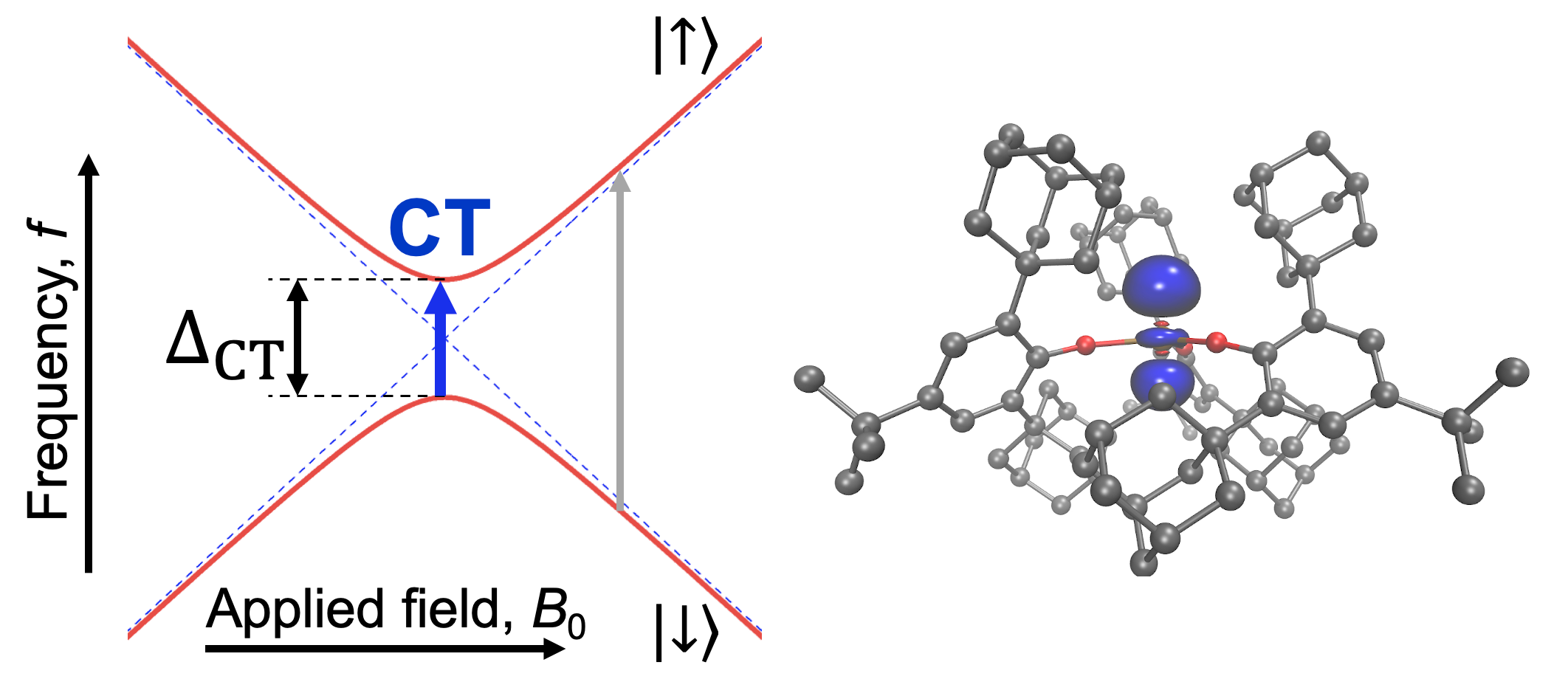
Due to their extensive magnetic tunability and potential for self-assembly-based scale-up, lanthanide single molecule magnets represent a promising next-generation qubit platform for quantum computing. In collaboration with the groups of Professor Evans at UCI and Professor Hill at FSU, we recently demonstrated the viability of this technology by highlighting a novel series of Ln complexes: [La(OAr*3)]-, [Lu(OAr*3)]-, and [Lu(NR2)3]- (OAr* = 2,6-Ad2-4-t-Bu-C6H2O, Ad = adamantyl, t-Bu= tert-butyl, R = SiMe3 with Me = methyl). We demonstrated through EPR and KS-DFT studies that variation of the s-orbital mixing present in the 6s/d Singly Occupied Molecular Orbital (SOMO) of these complexes could be used to tune their magnetic structure and subsequently engineer clock transitions, a type of hyperfine transition that is particularly resilient against quantum decoherence. We ultimately showed that [Lu(OAr*)3]- exhibited a massive clock transition of approximately 9 GHz resulting in enhanced magnetic relaxation times. The above figure depicts an illustration of a hyperfine clock transition (left) and the singly occupied molecular orbital density responsible for it in [Lu(OAr*)3]- (right). A publication is currently under review, and a preprint is available here: https://doi.org/10.26434/chemrxiv.14399333.v1
Predictions of Hyperfine Clock Transitions from Local Exact
Two-Component Theory
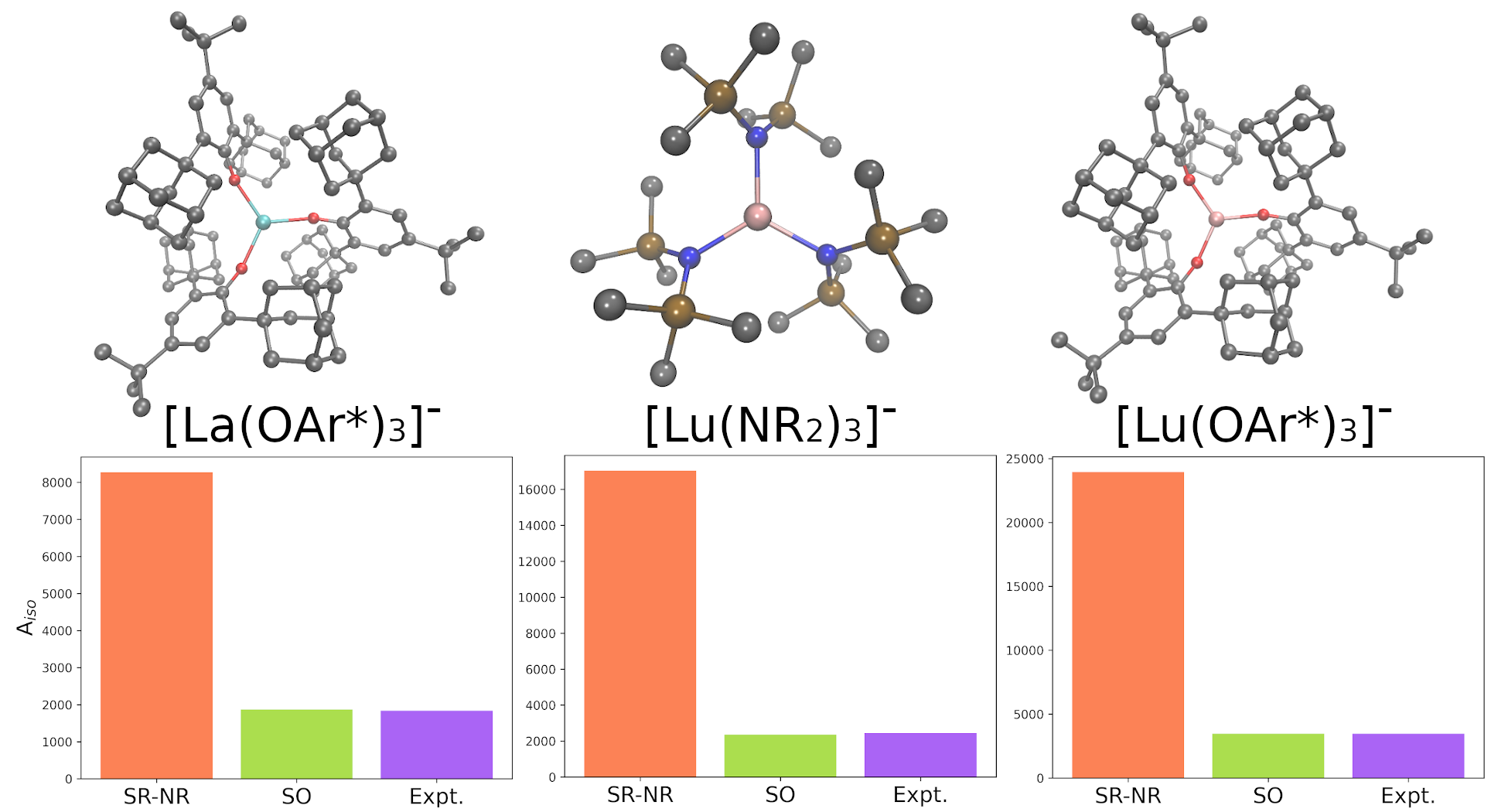
While KS-DFT successfully predicted the trends in hyperfine coupling for [La(OAr*3)]-, [Lu(OAr*3)]-, and [Lu(NR2)3]-, the values themselves possessed errors of roughly one order of magnitude when compared with experimental results. This can mostly be attributed to the non-relativistic operator used to calculate the HFC matrix, giving rise to a large picture-change error. While such a method proved useful when paired with experiment, improvements which can achieve quantitative accuracy are desired if in silico discovery of optimal SMMs is to be realized.
In collaboration with Yannick Franzke from the University of Marburg, we implemented the hyperfine coupling expression in the quasirelativistic exact two-component framework (X2C), which circumvents the errors described above. As illustrated in the above figure, our X2C, “SO”-based hyperfine coupling constants greatly reduce the error over the previous method (denoted “SR-NR” here), and brings them in line with experimental results. As such, we have realized an accurate tool capable of in-silico exploration of new single molecule magnet candidates. A publication is currently under review, and a preprint is available here: https://doi.org/10.33774/chemrxiv-2021-wnz1v
Characterization of Bis(pentaisopropylcyclopentadienyl) Terbium(II) and Dysprosium(II)

In a collaboration with the group of Professor Long, I studied the electronic properties of a series of novel low-valent, linear lanthanide complexes Dy(CpiPr5)2 and Tb(CpiPr5)2. We discovered that, contrary to prior predictions, the ground states associated with these species adopted 4fn 5d1 configurations, with significant 6s/5dz2 hybrid character in the HOMO. These compounds are now being further investigated for their suitability as single molecule magnets (SMMs). See the published article here: https://doi.org/10.1021/jacs.9b05816
Prediction of Bis(pentaisopropylcyclopentadienyl) Actinide Species

Through our previous work on Dy(CpiPr5)2 and Tb(CpiPr5)2, we also suspected that the analogous divalent actinide species would also be synthetically isolable. If so, these compounds would represent the first linear cyclopentadienyl complexes for the actinides, which were previously thought to be impossible to exist due to the known absence of covalent interactions within f-element species.
In our study (see: https://doi.org/10.1021/acs.inorgchem.9b02505), we found computational evidence for the accessibility of such compounds. Soon after our results were made available online, bis(cyclopentadienyl) uranium(II) was synthesized by Lafield et al., validating our own theoretical predictions.
Development of Ab-initio methods towards the description of Excited States for Periodic Systems
Quantum chemistry methods capable of describing the electronic structure of solids have long been desired in the fields of condensed matter physics and materials science. Knowledge of the excited state spectrum of technologically important materials, like those with light-harvesting or superconducting characteristics, is particularly crucial to the solution of difficult scientific and societal problems.
Part of my research involves developing methods derived from Coupled-Cluster theory to accurately predict excited-state properties of solids:
Equation-of-motion Coupled Cluster Theory for Solids
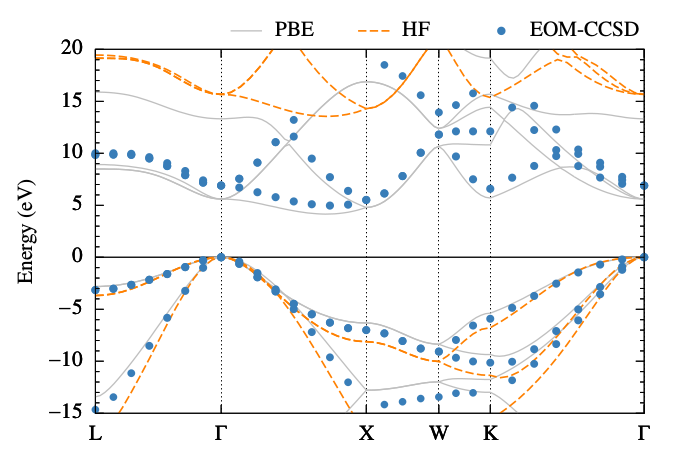
The Equation-of-motion Coupled Cluster technique has been used to obtain high-accuracy excited state properties for molecules in the past. The extension of this formalism to solids is a logical next step. This was first implemented by McClain et al. in the quantum chemistry software PySCF, and recently extended to unrestricted systems using spatial orbitals, as well as general systems with spin orbitals. A recent application to the bulk electronic properties of MnO and NiO can be found here: https://doi.org/10.1103/PhysRevB.101.165138
Coupled-Cluster Green’s Functions for Solids
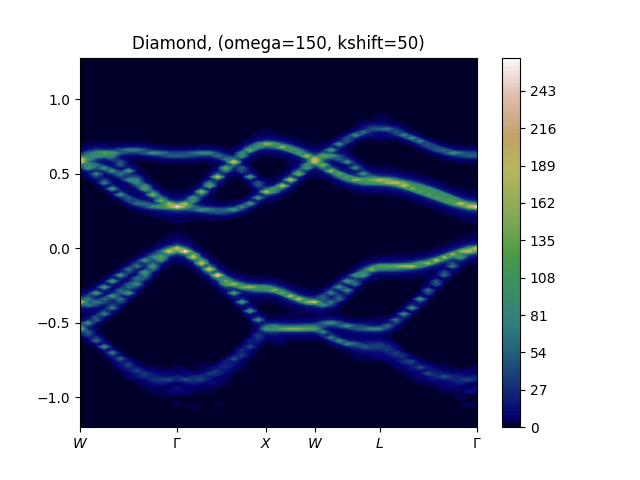
While the Equation-of-motion technique for solids has given promising results for description of quasiparticle energies, it has difficulty converging satellite states with larger many-body character. Because these states are important to understand the electronic properties of materials, a method to acquire these satellite states is desired.
The frequency-dependent Single-particle Green’s function, which can be evaluated directly in the Coupled Cluster Approximation, offers a potential solution to this issue. Its poles contain the quasiparticle energies of the many-body system, and can be found explicitly through its dependence on the energy. In my work on this project, I implemented an initial version of the Coupled Cluster Green’s Function method for Periodic systems in PySCF.
Genetic Algorithms for Fluorophore Determination
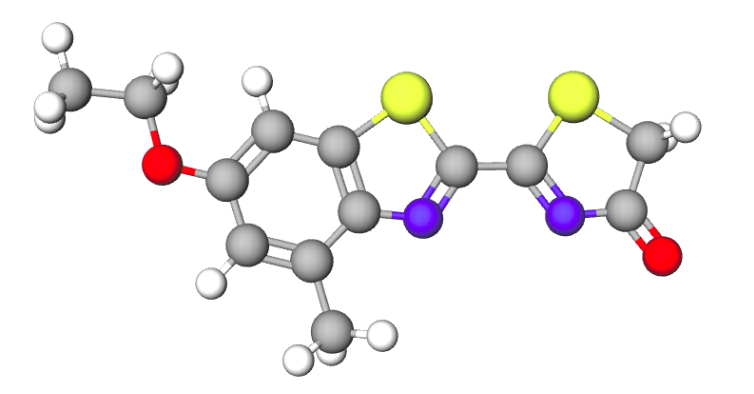
One of my past projects involved the development of a genetic algorithm to determine chemilluminescent probes for disease detection. Applying the algorithm to explore the chemical space of molecules derived from Luciferin, a chemical species responsible for the light given off by fireflies, I identified several candidates with strong fluorescent properties for further computational and experimental study. We hope to generalize this initial implementation to a variety of molecular base structures and apply it to additional chemical search projects in the future.